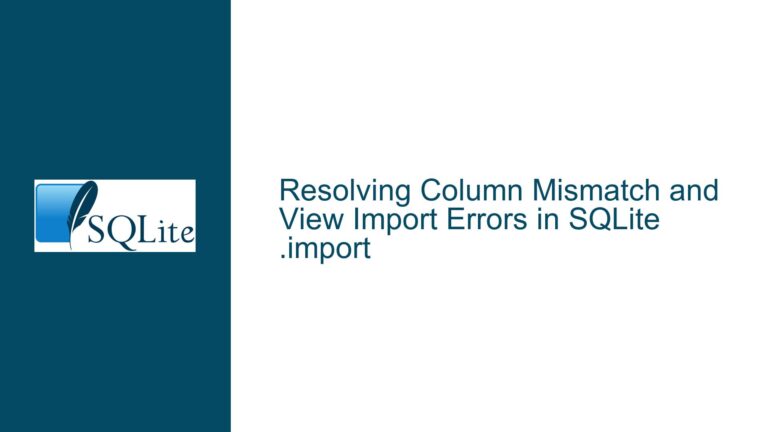SQLite Error: ‘all VALUES must have the same number of terms’ in INSERT Statement
Mismatched Column Count in INSERT Statement Leading to SQLite Error
The error message "all VALUES must have the same number of terms" in SQLite is a direct result of a mismatch between the number of columns specified in the INSERT statement and the number of values provided for those columns. This issue is particularly common when dynamically generating SQL queries, especially in applications where user input or external data sources are involved. In the context of the provided discussion, the error arises from an incorrectly formatted INSERT statement that attempts to insert data into a table with 11 columns but only provides values for a subset of those columns.
The core of the problem lies in the SQL statement:
INSERT INTO invoices (invoice_no, date, customer_name, gstin, product, hsn, uom, quantity, rate, amount, supplier)
VALUES (?,?),('list')
Here, the INSERT statement specifies 11 columns (invoice_no, date, customer_name, gstin, product, hsn, uom, quantity, rate, amount, supplier), but the VALUES clause only provides two placeholders ((?,?)) and a single string value (('list')). This discrepancy triggers the SQLite error because the database engine expects each VALUES term to correspond exactly to the number of columns listed in the INSERT statement.
Incorrect SQL Syntax and Misaligned Placeholders
The root cause of this error is twofold: incorrect SQL syntax and misaligned placeholders. SQLite requires that the number of placeholders in the VALUES clause matches the number of columns specified in the INSERT statement. In the provided example, the VALUES clause contains only two placeholders ((?,?)) and a literal string (('list')), which does not align with the 11 columns defined in the table schema.
Additionally, the use of a Python list (list = ['invoice_number', 'invoice_date', 'name', 'customer_gstin', 'product', 'hsn', 'uom', 'quantity', 'rate', 'amount', 'supplier']) suggests an attempt to dynamically generate the VALUES clause. However, the list is not correctly integrated into the SQL statement. Instead of being used to populate the placeholders, the list is treated as a literal string, further exacerbating the issue.
The problem is compounded by the fact that the SQL statement is being constructed within a Python function (proceed_raise_invoice), where variables such as invoice_number, invoice_date, name, customer_gstin, product, hsn, uom, quantity, rate, amount, and supplier are intended to be passed as parameters to the query. However, the current implementation does not correctly map these variables to the placeholders in the SQL statement.
Correcting the INSERT Statement and Ensuring Data Consistency
To resolve this issue, the INSERT statement must be revised to ensure that the number of placeholders in the VALUES clause matches the number of columns specified in the INSERT statement. Additionally, the Python code must be updated to correctly pass the variables to the SQL query.
Step 1: Revise the INSERT Statement
The corrected INSERT statement should include 11 placeholders, one for each column in the invoices table:
INSERT INTO invoices (invoice_no, date, customer_name, gstin, product, hsn, uom, quantity, rate, amount, supplier)
VALUES (?, ?, ?, ?, ?, ?, ?, ?, ?, ?, ?)
This ensures that the number of placeholders matches the number of columns, allowing SQLite to correctly interpret the query.
Step 2: Update the Python Code to Pass Variables Correctly
The Python function proceed_raise_invoice must be updated to correctly pass the variables to the SQL query. This involves retrieving the values from the Tkinter widgets and passing them as a tuple to the execute_query function. Here is an example of how this can be done:
def proceed_raise_invoice():
invoice_number = invoice_number_entry.get()
invoice_date = date.today().strftime('%Y-%m-%d')
name = name_combobox.get()
customer_gstin = customer_gstin_label.cget("text")
product = product_entry.get()
hsn = hsn_combobox.get()
uom = uom_entry.get()
quantity = int(quantity_entry.get())
rate = int(rate_entry.get())
amount = quantity * rate
supplier = supplier_combobox.get()
create_invoices = """
INSERT INTO invoices (invoice_no, date, customer_name, gstin, product, hsn, uom, quantity, rate, amount, supplier)
VALUES (?, ?, ?, ?, ?, ?, ?, ?, ?, ?, ?)
"""
values = (invoice_number, invoice_date, name, customer_gstin, product, hsn, uom, quantity, rate, amount, supplier)
execute_query(connection, create_invoices, values)
In this updated code, the values tuple contains the values retrieved from the Tkinter widgets, which are then passed to the execute_query function along with the create_invoices SQL statement. This ensures that the correct number of values is provided for each placeholder in the INSERT statement.
Step 3: Validate Data Before Insertion
To further ensure data consistency and prevent errors, it is advisable to validate the data before attempting to insert it into the database. This can include checking for empty or null values, ensuring that numeric fields contain valid numbers, and verifying that date fields are in the correct format. Here is an example of how data validation can be implemented:
def validate_invoice_data(invoice_number, name, product, hsn, uom, quantity, rate, supplier):
if not invoice_number:
raise ValueError("Invoice number cannot be empty")
if not name:
raise ValueError("Customer name cannot be empty")
if not product:
raise ValueError("Product name cannot be empty")
if not hsn:
raise ValueError("HSN code cannot be empty")
if not uom:
raise ValueError("Unit of measure cannot be empty")
if quantity <= 0:
raise ValueError("Quantity must be greater than zero")
if rate <= 0:
raise ValueError("Rate must be greater than zero")
if not supplier:
raise ValueError("Supplier cannot be empty")
def proceed_raise_invoice():
try:
invoice_number = invoice_number_entry.get()
invoice_date = date.today().strftime('%Y-%m-%d')
name = name_combobox.get()
customer_gstin = customer_gstin_label.cget("text")
product = product_entry.get()
hsn = hsn_combobox.get()
uom = uom_entry.get()
quantity = int(quantity_entry.get())
rate = int(rate_entry.get())
amount = quantity * rate
supplier = supplier_combobox.get()
validate_invoice_data(invoice_number, name, product, hsn, uom, quantity, rate, supplier)
create_invoices = """
INSERT INTO invoices (invoice_no, date, customer_name, gstin, product, hsn, uom, quantity, rate, amount, supplier)
VALUES (?, ?, ?, ?, ?, ?, ?, ?, ?, ?, ?)
"""
values = (invoice_number, invoice_date, name, customer_gstin, product, hsn, uom, quantity, rate, amount, supplier)
execute_query(connection, create_invoices, values)
except ValueError as e:
print(f"Validation error: {e}")
except Exception as e:
print(f"An error occurred: {e}")
In this updated code, the validate_invoice_data function checks that all required fields are populated and that numeric fields contain valid values. If any validation checks fail, a ValueError is raised, and the insertion is aborted. This helps to prevent invalid data from being inserted into the database, which could lead to further issues down the line.
Step 4: Implement Error Handling and Logging
In addition to data validation, it is important to implement robust error handling and logging to capture and diagnose any issues that may arise during the execution of the SQL query. This can include logging errors to a file, displaying error messages to the user, and rolling back transactions in case of failure. Here is an example of how error handling and logging can be implemented:
import logging
logging.basicConfig(filename='invoice_errors.log', level=logging.ERROR)
def proceed_raise_invoice():
try:
invoice_number = invoice_number_entry.get()
invoice_date = date.today().strftime('%Y-%m-%d')
name = name_combobox.get()
customer_gstin = customer_gstin_label.cget("text")
product = product_entry.get()
hsn = hsn_combobox.get()
uom = uom_entry.get()
quantity = int(quantity_entry.get())
rate = int(rate_entry.get())
amount = quantity * rate
supplier = supplier_combobox.get()
validate_invoice_data(invoice_number, name, product, hsn, uom, quantity, rate, supplier)
create_invoices = """
INSERT INTO invoices (invoice_no, date, customer_name, gstin, product, hsn, uom, quantity, rate, amount, supplier)
VALUES (?, ?, ?, ?, ?, ?, ?, ?, ?, ?, ?)
"""
values = (invoice_number, invoice_date, name, customer_gstin, product, hsn, uom, quantity, rate, amount, supplier)
execute_query(connection, create_invoices, values)
except ValueError as e:
logging.error(f"Validation error: {e}")
print(f"Validation error: {e}")
except Exception as e:
logging.error(f"An error occurred: {e}")
print(f"An error occurred: {e}")
In this updated code, the logging module is used to log errors to a file named invoice_errors.log. This allows for easier diagnosis of issues that may occur during the execution of the SQL query. Additionally, error messages are displayed to the user, providing feedback on what went wrong and how to correct it.
Step 5: Optimize the Database Schema and Query Performance
Finally, it is important to consider the performance implications of the database schema and the SQL queries being executed. In the context of the provided discussion, the invoices table schema appears to be well-structured, with appropriate data types and constraints. However, there are a few optimizations that can be made to improve performance and ensure data integrity.
Indexing Frequently Queried Columns
If the invoices table is expected to grow large, it may be beneficial to add indexes to frequently queried columns, such as invoice_no, date, and customer_name. Indexes can significantly speed up query performance by allowing the database engine to quickly locate the rows that match the query criteria. Here is an example of how to add an index to the invoice_no column:
CREATE INDEX idx_invoice_no ON invoices (invoice_no);
Using Transactions for Data Integrity
When inserting multiple rows into the database, it is important to use transactions to ensure data integrity. Transactions allow you to group multiple SQL statements into a single unit of work, which can be committed or rolled back as a whole. This ensures that either all the statements are executed successfully, or none of them are, preventing partial updates that could lead to data inconsistencies. Here is an example of how to use transactions in Python with SQLite:
def proceed_raise_invoice():
try:
connection = sqlite3.connect('invoices.db')
cursor = connection.cursor()
invoice_number = invoice_number_entry.get()
invoice_date = date.today().strftime('%Y-%m-%d')
name = name_combobox.get()
customer_gstin = customer_gstin_label.cget("text")
product = product_entry.get()
hsn = hsn_combobox.get()
uom = uom_entry.get()
quantity = int(quantity_entry.get())
rate = int(rate_entry.get())
amount = quantity * rate
supplier = supplier_combobox.get()
validate_invoice_data(invoice_number, name, product, hsn, uom, quantity, rate, supplier)
create_invoices = """
INSERT INTO invoices (invoice_no, date, customer_name, gstin, product, hsn, uom, quantity, rate, amount, supplier)
VALUES (?, ?, ?, ?, ?, ?, ?, ?, ?, ?, ?)
"""
values = (invoice_number, invoice_date, name, customer_gstin, product, hsn, uom, quantity, rate, amount, supplier)
cursor.execute("BEGIN TRANSACTION;")
cursor.execute(create_invoices, values)
cursor.execute("COMMIT;")
except ValueError as e:
logging.error(f"Validation error: {e}")
print(f"Validation error: {e}")
cursor.execute("ROLLBACK;")
except Exception as e:
logging.error(f"An error occurred: {e}")
print(f"An error occurred: {e}")
cursor.execute("ROLLBACK;")
finally:
cursor.close()
connection.close()
In this updated code, the BEGIN TRANSACTION, COMMIT, and ROLLBACK statements are used to manage transactions. If any error occurs during the execution of the SQL statements, the transaction is rolled back, ensuring that the database remains in a consistent state.
Conclusion
The "all VALUES must have the same number of terms" error in SQLite is a common issue that arises when there is a mismatch between the number of columns specified in an INSERT statement and the number of values provided. By carefully revising the SQL statement, correctly passing variables from the application code, validating data before insertion, implementing robust error handling and logging, and optimizing the database schema and query performance, this error can be effectively resolved. Following these best practices will not only fix the immediate issue but also improve the overall reliability and performance of the application.






